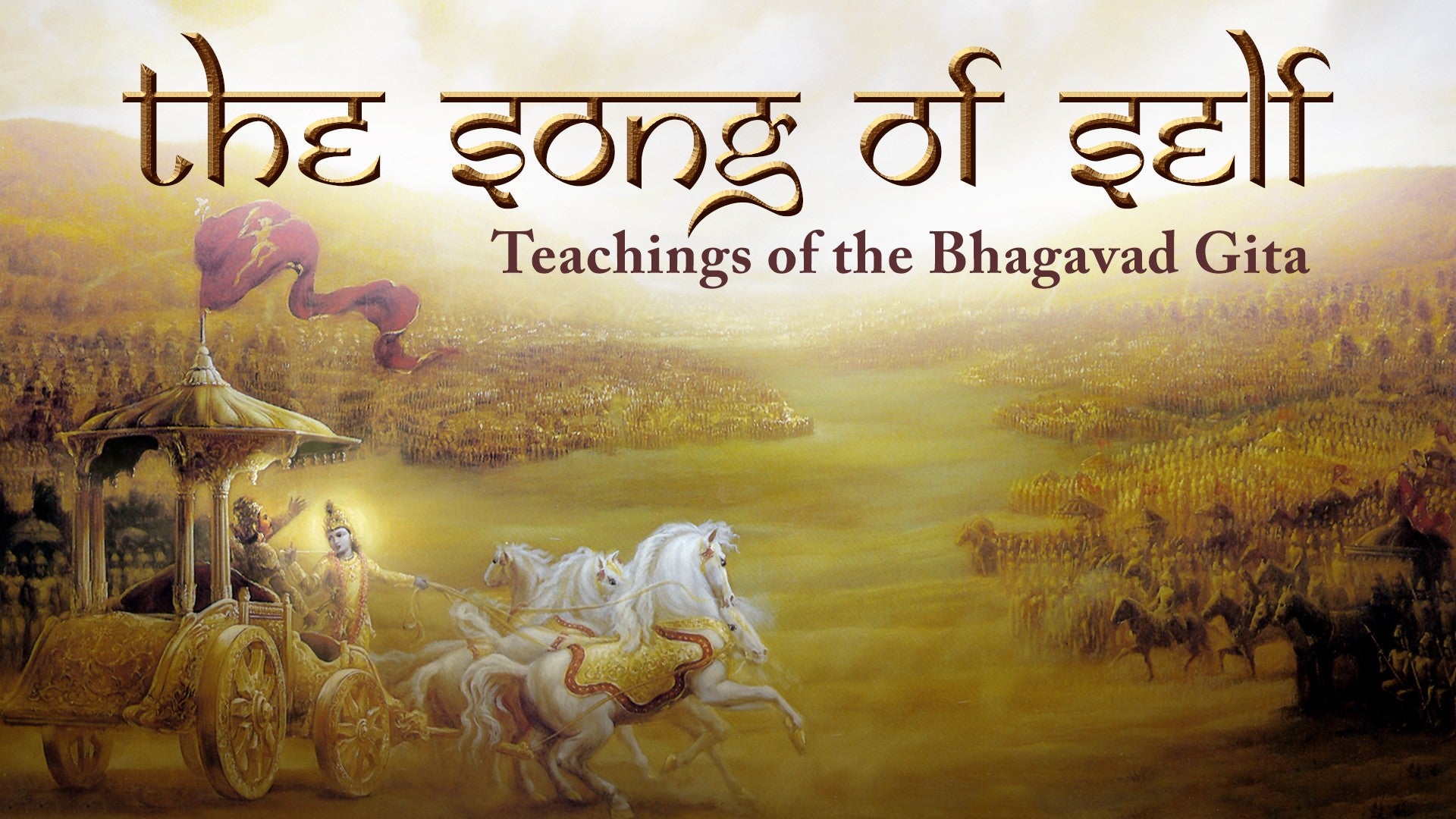Description
We have attached a PDF of the chart so that you can follow along with us.
About This Video
Transcript
Read Full Transcript
So we're going to start studying chapter 2, but before we do that we're going to just mention briefly the background. And I'd like to start by mentioning the very first verse of the Bhagavad Gita, because we've already mentioned that it can seem a bit puzzling. This is about yoga, so of all the places to set the action, why a battlefield? Now the very first verse is spoken by a character in the Mahabharata called Dhritharashtra, and he's the blind king. And the battle that's going to be joined is basically involving his sons and his nephews. But he's blind, so he asks one of his ministers, Sanjaya, and tell him what's going on. Sanjaya's going to be like his commentator on the action, he can't see it, just like if you wanted to go and see the match, a sports game, but you couldn't, you might choose to listen on the radio. So Dhritharashtra he can't see, so Sanjaya is going to tell him what's going on. And so Dhritharashtra asks him, he asks him this, he says, dharmakshaitre kurukshaitre samaveta yoyotsavaha mamakapandavashchayiva kimakurvata sanjaya. So he asks Sanjaya kimakurvata, what happened? What happened when mamakap, maybe you can guess from the gesture, ma means my, when my sons, pa navashchayva and the sons of Pandu, who was his brother, so his nephews, samaveta yoyotsavaha, when they came together, samaveta yoyotsavaha, ready and eager to do battle, to fight. But where did they come together? Dharmakshaitre kurukshaitre, kshaitra means field, kshaitre means on the field or in the field, in the field of kuru and in the field of dharma. So when my sons and the sons of my nephew, when they came, excuse my brother, excuse me, my nephews, when they came together, eager to do battle, in the field of kuru, the field of dharma, what happened? Now here it's very interesting because field, kshaitra, Krishna himself says that this is the kshaitra of a human life. This is our field where we experience reality. And the question refers to the field of dharma and the field of kuru. Now kuru, kurukshaitra, is actually a physical geographical location. It's a place and you can go there in India. However, it's also much more than that because kuru is from the Sanskrit root kra, to do do, to make, to act. So kurukshaitra literally means the field of action. And then dharma, this word dharma is an important word in the Gita and in Indian philosophy and in yoga in general. So what does it mean? You can find it translated scores of ways at least, perhaps even hundreds, because the word has quite a wide reach. But the actual root, dr, means that which supports or sustains. So one way we can kind of think of dharma is it's the action which sustains the smooth rotation of the wheel of natural law. So you may have seen sometimes in Buddhist iconography particularly, they use the dharma chakra, the wheel of dharma. And it's the idea that when things are aligned in a harmonious way, then the wheel can actually rotate smoothly. So dharma is that type of action which allows all the different spokes of the wheel, all the different members of the group, all the different occupiers of the field to actually rotate in harmony. Like for example, if you have a bicycle, we call it a bicycle, something having two wheels, but these days many of these very kind of fast bicycles have many wheels, because the gears have got all these other wheels. And if the cogs of the gears are nicely aligned with minimal effort, you can get the maximal power from the gear mechanisms. But if those wheels are not so well aligned, what happens? Every time you pedal, you're kind of losing energy. So dharma is that action, is that way of acting which allows all the constituent members to work in a sustainable harmonious way, we might say. So the blind king asks his minister, what happened when my sons and the sons of my brother met, he gets to do a battle, on the field of action, the field of dharma. Now, marmaka, his nephews previously, he has spoken of them like they're his own sons, like they're his own children. But now he's creating this differentiation, he's rejecting them, he's seeing them as the enemy. So really what we're seeing here is that he is putting what we could call his own short-term selfish interests on one side and the well-being of the whole on the other. And then the question then is what happens when those tendencies within us which are only interested in our short-term goals, our short-term interests clash with those parts of ourselves that actually have a broader vision and would guide us towards a more cohesive and more sustainable way of really being in harmony. So we can illustrate this by considering this new addition to the shot that you might have noticed here. So this is actually a blown up and nicely produced version of a handwritten document that I made when I was teaching in India recently. And the Bhagavad Gita, as we've said, is set on the battlefield. But this field is really the field of our human experience. So I mentioned here the Bhagavad Gita. Gita means song. And Bhagavan means the Lord, the one who's a master. The one who's a master to the degree that he is a master of all of himself. So we could translate the Gita as the song of totality, as a song of the Lord or the song of mastery. It's teaching us to be the master and the sovereign of our own experience. Sometimes the name of the Gita is prefixed with Srimad, which means the glorious Bhagavad Gita. So Bhagavan is the name for the Lord. And when it's preceding the Gita word, then it changes to Bhagavad. So it's the glorious song because it's teaching us how to actually grow into our unique, glorious potential. And it's set in the field of human experience. And the Gita recognizes that when we're a human being, it's altogether normal and natural to experience. Sometimes we feel a bit split. Sometimes we feel we're not quite all working as one. Parva wants to go in one direction. Another part would like to go in a different direction. And so in the Gita, in the Mahabharata term, the battle is between these two sets of cousins. So they're cousins. So they all grew up together, just like those tenancies inside ourselves that would lead us in one direction and other tenancies that would lead us somewhere else. They know each other. They've grown up together. They live in the same field. And the two sets of armies, the two sets of cousins and their allies, are referred to as the Kauravas and the Pandavas. Now Dhritarashtra, the blind king, his brother was called Pandu. And Pandu means the pure one. So the Pandavas, they represent, we might say, those pure, noble tenancies inside, those tenancies that would lead us towards sustainable well-being and harmony. And this is one side, we might say. And the other set of cousins, they're the Kauravas. Now Kaurava means coming from Kuru. And Kuru is the name of the land where this takes place. So the Pandavas are also actually Kauravas because they're also from this land. But why are the Kauravas called the Kauravas and the Pandavas are called the Pandavas. We've already mentioned the Pandavas, they're the pure ones. But Kuru, remember we mentioned Kuru is from the root kre to do. So the way we can consider it is the Kauravas represent those parts of ourselves that are bound by our actions. They represent those tendencies which they can only work with what they've already experienced. So they're bound and limited. So this idea in yoga of Karma Bandhana, the binding influence of action, we do something and it leaves an impression. And that impression then creates a desire for more if it was a pleasing thing or to avoid it if it wasn't pleasing. And the urge that because of Karma Bandhana, the binding influence of action, it sometimes stops us doing what we really long to do because we get veiled by the impressions of our previous experiences. And so sometimes there is actually something we really long for but we don't do it because our conditioning screams at us, no, no, you can't do that. Even if we long to do that.
And so this is the idea of the struggle between those noble tendencies and those tendencies that would chain us to the limited ways of being that we're familiar with up to this point but which perhaps now are no longer inclusive enough to really help us inhabit the type of space we want in the field of our actual experience. So it's the idea that if we can actually harmonize this field, then we can come to mastery. Now in the Gita, a particularly important figure is Arjuna because he's the student and his teacher is Krishna. Arjuna, his name, like the name of his father, also means pure or clear. So the idea he has pure intent and this is one of the things that qualifies him to be the student because his motivation is pure. And the teacher in the Gita is Krishna. Now Krishna is one of the great archetypes in the yogic tradition and there's many things we can say about Krishna. But in the context of the Gita, he is the master, he's the teacher, he's also the Lord. So the idea that he's a human being but he's truly master of what it means to be human. He's also kind of divine but he understands the human condition so he's perfectly qualified to be the teacher because he can understand why it might not always be so easy for Arjuna who represents the human being. Now literally Krishna means black. As a noun, it means black or dark. And as a verb, it's from the root krishkarshati which means to draw towards or to attract. And so Krishna here is in the middle of the field or the middle of, this could be a circle. Here it's oval but we could think of it as a circle. So Krishna, we could think of it as the black hole at the centre of the universe which attracts everything towards it. And we could also think of it as the voice of conscience deep within the cave of our own heart. When we become still, we can access its wisdom. It's always in there.
It can speak to us but we can only really tune into it when we get clear. When our thoughts get purified, things settle down and we can see more clearly and we can truly incarnate the energy of Arjuna then we can access the wisdom of Krishna that resides in the cave of our heart, we might say, in the unknown depths of our innate wisdom. And it's important to recognise that the Gita and Yoga recognise that we actually are blessed and imbued with many innate gifts once we're a human being. So in Yoga, they say that when you're a human being, you're so fortunate because you have self-reflexive awareness. We can watch ourselves, we can listen to ourselves, we can feel ourselves and hence we have the capacity for Samadhi, we have the capacity to feel our integration. So the Pandavas, there are five of them. So in this battle, it's about to be joined when the Gita begins. On the one side, we have the Kauravas. And the Kauravas, their leader, the eldest of the Kaurava sons, is called Duryodhana. And this means difficult to overcome in battle, hard to beat. He's also known as Suyodhana, which means the one who's very tough, very strong in battle. And I think we can probably agree that sometimes it is tough to overcome very well entrenched patterns that have developed through our habits over the years. Even if we've recognised that, oh, this habit's no longer serving me, sometimes it's not so easy to leave it behind and hence Duryodhana, hard to overcome. The Pandavas on the other hand, so he's there Duryodhana with 98 of his brothers and they have an army about 11 million strong. The Pandavas meanwhile, there's just five of them and there are five of these brothers. And these brothers are all actually the sons of gods. So we'll come to that story perhaps. But for now, we'll just talk about these five brothers and what their name symbolises. So the first of the Pandavas, the eldest, is called Yudhishthira. And Yudhishthira literally means the one who is steady in conflict. Now in yoga, it's one of the key ideas that when we feel disturbed, if we come to steadiness, we'll be able to find a more efficient response or to respond perhaps more skilfully. So Yudhishthira, his father was the god called Dharma. In other words, he's the one who knows the way that's conducive to that smooth rotation of the wheel of natural law. And so we can consider Yudhishthira to represent the power of our conscience. Because the idea that deep down, we often do know what is the most appropriate course of action for us in challenging situations. Yet sometimes we kid ourselves that we don't know what to do. Maybe you've been in such a situation, you think, I already don't know what to do. But actually we do. It's just we don't want to do that. And so this is the area of the conscience. It's the voice inside of that deep intuitive wisdom. But we have to be steady and kind of courageous to listen to it and access it. But the area is always there. Our conscience is always with us. We might muffle it and drown it out. But as we start to pay more attention to it, we can rehabilitate its power and we can trust it more and more. Now the second of the Pandavas, the second son, is the son of Vayu, who is the wind. So the wind is so powerful. And so Bhima, he's called the one of terrible deeds because he's so strong. They say he's the strongest man in the whole world. Now being the son of the wind, we are also, we might say, children of the wind because we depend on the air and the oxygen and all those other qualities in the air for our life. And in Sanskrit, one of the words for the life force or the Vaita Vani is called prana. And this doesn't actually equate to the wind or the breath, but it's connected to it. It moves through the air. This is one of the things that helps prana circulate. And so Bhima, we can consider him as representing the vital force or the animal power within us, the animal power within us. So in the world we live in today, it can be quite easy to become estranged from our animal power. If you spend time in the wilderness, and I've been fortunate to do this for a few weeks in each of the last three years, and you observe the animals in the wild, it's quite striking that when you look at the animals in the wild, they're all in great shape. And they don't have several supermarkets to choose from in their local neighborhood, but somehow they manage and they know how to eat just enough of just the right thing to stay live and mobile and be able to really navigate their environment quite skillfully, quite easily. And yet in the human world, we see that often we don't necessarily know how to eat very well. I don't think I've met any human beings who's really a master of food and knows exactly what to eat and exactly the right amount to always be able to kind of be in that harmonious state. So it's the idea that we do have that intelligence in our tongue. Our senses are imbued with all the knowledge and wisdom we need to guide us to food and other types of nourishment to stay healthy and stay balanced. So Bhima represents the true majestic force that's possible when we harness the gifts of our animal nature in a very conscious way. Then Arjuna, he's the middle of the five. He's the, like in Spanish, if you have like the things of the hand, they call the third finger. I'm in America, so I have to make sure I hold my hand this way, not that way. But the middle finger here, they call it in Spanish, the coronal, the heart finger, because it's the middle one, it's in the middle. So Arjuna, he's the middle of these five. And he actually represents, I think we can say, pure heartedness. He represents the power of sincerity. When you do something in a wholehearted way, you've got a really good chance of learning from it. You might not always be completely successful, but if we're sincere and we do something with wholeheartedness, we can be quite confident we're going to learn a lot from it. So the last two at the Pandavas, their names are actually particularly interesting. And they're the sons of the Ashwin twins, who are the celestial physicians. So in the Indian pantheon of gods, there are these two twins, the Ashwin twins, who are like the great doctors. You need a tonic, they know what to give you. You need some serious healing or some surgery, you go to them, they take care of you. And these two, they are the sons of the Ashwin twins. Next is Nakulan, the second is Sahadeva. Now Nakulan in Sanskrit means mongoose. And mongoose in Sanskrit is a very interesting word, because as soon as you hear mongoose or Nakulan in Sanskrit, we immediately have the strong association with snakes and mice. Because mice and snakes are said to be the perpetual enemies of the mongoose. But the mongoose is able to protect itself from the snake's venom by the sap of the Nakuli plant. And hence it has the name Nakulan. So Nakulan we can say, he represents our innate capacity to stay safe, to protect ourselves from what we might refer to as the poison of worldly existence, and instead engage with the world in healthy ways. So it's the idea in yoga that the world is as it is. There are certain things you can work with them in healthy ways, but if you have too much of them or not enough of them, it can be harmful. So Nakulan, he represents that innate intuitive wisdom that can keep us safe. If we're in a situation, it's the intuition that can lead us in such a way that we can work profitably, easefully, skillfully, safely, even with challenging unknown situations. Then his brother is called Sahadeva, and this literally means with the gods. Now Krishna, in the third chapter of the Gita, he will say that when human beings came into existence, at the same time, there came about this principle called Yagya. Now Yagya basically means to make something we do a very conscious act, to make it something almost sacred by doing it with great awareness. Sometimes people translate Yagya as sacrifice, but sacrifice in the sense of making it sacred. How do you make something sacred by doing it with great awareness? So Sahadeva, he represents the power of self-reflexive awareness. Because we can notice ourselves doing things, hear ourselves, feel ourselves, we can learn quickly what is conducive to balance and harmony, and what are those things that perhaps aren't so conducive to balance and harmony. So the idea of the Pandavas, they represent these great capacities we have within us to stay safe and to gravitate towards that which is going to be conducive to dharma, to that sustained long-term well-being. And so this is the clash between those tendencies within us which are just based on our experiences up to now and which might continue to leave us limited or in a certain degree of pain or suffering, and those tendencies that would lead us further on the courageous path to wholeness. And this is the field of action and this is where the Gita is set. So it's not just set on a battlefield in this ancient story, it's the idea that where is that story really set? Where is it really happening? Right now, here, in the middle, in the thick of life, in the whirling wonder of it all, this is where we can experience yoga and this is where the clash happens. Any time when what we've relied on up to now is no longer inclusive enough to really represent our deeper longing, then there'll be that clash between the old habits, the old patterns that are no longer really inclusive enough and that tendency to courageously go into the unknown. So this is what it's all about. So, from here, we're going to start with the verses.
The Song of Self: Let's Begin
Comments

You need to be a subscriber to post a comment.
Please Log In or Create an Account to start your free trial.

















